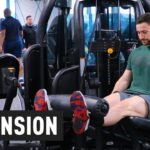Smith Machine Front Squat: Exercise Overview
The Smith machine front squat is a potent compound exercise that emphasizes the quadriceps while also engaging the glutes, hamstrings, core, and upper back. By using the Smith machine’s fixed bar path, this variation reduces the need for stabilization compared to free-weight front squats, allowing lifters to focus on leg strength and proper form. Ideal for building lower-body power and muscle definition, the Smith machine front squat supports functional fitness and is suitable for leg-focused workouts, lower-body sessions, or full-body routines. It’s an excellent option for lifters of all levels, particularly those refining technique or working in gyms with limited equipment (Schoenfeld, 2010).
How to Perform the Smith Machine Front Squat
- Set the Smith machine bar just below shoulder height and load it with an appropriate weight.
- Step under the bar, positioning it across the front of your shoulders (against your collarbone), and either grasp it with a front rack grip (two or three fingers) or place your hands over your shoulders for stability—this is your starting position.
- Unrack the bar by rotating your wrists to release the safety catches, standing with feet hip- to shoulder-width apart and toes angled comfortably.
- Lower your body by bending your knees and pushing your hips back, keeping your torso upright, until your thighs are parallel to the floor or slightly below.
- Drive through your entire foot (big toe, little toe, heel) to extend your knees and hips, returning to the starting position without locking out your knees.
- Repeat for the desired number of repetitions.
Tips for Optimal Performance
- Maintain an Upright Torso: Keep your elbows elevated and chest lifted to prevent forward lean, ensuring quad emphasis and reducing lower-back strain (Escamilla et al., 2001).
- Adjust Grip for Comfort: Use a front rack grip with two or three fingers or a cross-arm grip if wrist mobility is limited to maintain bar stability and reduce discomfort.
- Control Knee Tracking: Allow some forward knee movement over the toes, especially for those with longer femurs, but ensure knees track over or slightly outside the second toe to protect joints (Wirth et al., 2016).
- Drive Through Whole Foot: Distribute weight evenly across your foot to engage both quads and glutes effectively, avoiding excessive heel or toe pressure.
- Breathe Properly: Inhale before descending and exhale as you push back up to support core stability and muscle oxygenation (McGill, 2010).
- Experiment with Toe Angle: Adjust toe angles (neutral, slightly in, or out) based on your hip anatomy and ankle mobility to find the most comfortable stance (Schoenfeld, 2016).
Building quads with front squats? Learn how they enhance leg strength in our Ultimate Guide to Muscle Groups.







